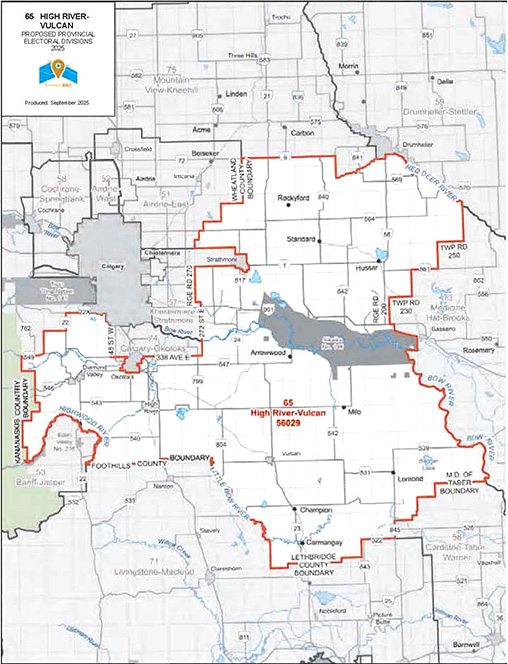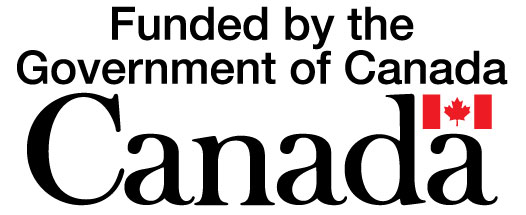Current Temperature
5.7°C
MLA Hunter concerned about proposed Taber-Warner boundary changes
Posted on November 20, 2025 by Taber Times Times Map Supplied.
NEW RIDING: If proposed electoral boundary changes for southern Alberta come to pass, the current Cardston-Siksika riding (west and north of the present Taber-Warner constituency) will be eliminated in favour of expanding west to create a new Cardston-Taber-Warner electoral district. The proposed new High River-Vulcan riding (north and west of Lomond) would be carved out of the remnants of Cardston-Siksika with some geographical additions from other existing ridings.
Times Map Supplied.
NEW RIDING: If proposed electoral boundary changes for southern Alberta come to pass, the current Cardston-Siksika riding (west and north of the present Taber-Warner constituency) will be eliminated in favour of expanding west to create a new Cardston-Taber-Warner electoral district. The proposed new High River-Vulcan riding (north and west of Lomond) would be carved out of the remnants of Cardston-Siksika with some geographical additions from other existing ridings.By Trevor Busch
Taber Times
editor@tabertimes.com
Sweeping boundary changes are being proposed for the current Taber-Warner electoral district in the province’s recent Interim Electoral Boundaries Report.
Redrafting the constituency into a new Cardston-Taber-Warner riding would bring in a large area north of the Oldman River including Vauxhall and the province’s southwest region including Cardston, the Blood Reserve and Waterton – essentially a redrawn version of the previous Cardston-Taber-Warner electoral district that existed from 1996 to 2017.
Taber-Warner MLA Grant Hunter is less than enthusiastic about the proposed changes, citing issues involving effective representation of the Highway 3 agri-food corridor.
“I’m not happy about the proposed boundary changes for Taber-Warner. I hope that’s just the first iteration, and we’ll see what happens in the future. In 2015 I was first elected in Cardston-Taber-Warner, so I understand that kind of thinking, but the reality is that right now what’s going on is you’ve got an agri-food processing corridor that has to be represented by MLAs and municipal leaders. And I think that it’s not with the boundary redistribution. It takes Coaldale out, it takes Lethbridge and puts it somewhere else.”
Drafted by the provincial government’s Electoral Boundaries Commission (EBC), the interim report is a response to the substantial increase in Alberta’s population over the last eight years and the EBC Act which requires a review of all provincial constituency boundaries before the next Alberta general election.
The Commission reported that “changes to provincial law in the fall of 2024 increased the number of constituencies from 87 to 89 for the next general election,” and it is required to review the boundaries and provide a final report to the Legislative Assembly by March 28, 2026. It submitted the interim report to Speaker Ric McIver on Oct. 27.
A portion of Cardston-Siksika (which would be eliminated as an existing riding under the proposed changes) and Taber-Warner would be merged on the map and the boundary lines would create a vast new district north of the US-Canada border. The region north of Lethbridge extending to Vulcan would be removed from Cardston-Siksika and reestablished within the Livingstone-Macleod and High River-Vulcan districts.
“I don’t think that’s actually the right iteration when it comes to the work we’ve done for the past six years on that agri-food processing corridor,” said Hunter. “I think Canada’s Premier Food Corridor has to be taken into consideration when you put those things together – that’s a boundary together.”
Eliminating Cardston-Siksika in favour of a new Cardston-Taber-Warner constituency could also result in some potentially sticky issues involving the future UCP nomination, as current Cardston-Siksika MLA Joseph Schow hails from an area of that riding that could be slated for incorporation into the new Cardston-Taber-Warner electoral district.
Public meetings both before and after the interim report has been made are a requirement under provincial law. Residents can send written submissions to the Commission at abebc.ca. A schedule of public meetings will be posted on the website on Nov. 24.
“So every eight years those boundaries are re-established, and so that would be in 2027 when the next election is,” confirmed Hunter.
Cardston-Taber-Warner (proposed, formerly Taber-Warner)
The boundaries of the proposed electoral division of Cardston-Taber-Warner would result in a population of 54,933. Under the proposed redrafting of the present Taber-Warner riding, the Cardston-Taber-Warner electoral division would undergo significant changes from the current boundaries of existing ridings Taber-Warner and Cardston-Siksika to reflect changes in the distribution of the population of Southern Alberta.
“It is recommended that all of Cardston County, and its towns of Cardston and Magrath, be joined to the electoral division,” reads an excerpt from the interim report. “The fact that there was a previous version of Cardston-Taber-Warner underscores to the Commission that this electoral division contains communities of interest that can be effectively represented. History proves that this configuration can provide effective representation.”
Several changes are being proposed to better align municipal boundaries.
“To slightly reduce the population and keep communities of interest in common, it is… recommended that portions of Lethbridge County that had been in Taber-Warner be moved to Livingstone-Macleod. This keeps Lethbridge County in a single electoral division. In a similar vein, portions of the MD of Taber, which were previously not in Taber-Warner, are recommended for inclusion in Cardston-Taber-Warner to better balance population and use municipal boundaries to create clear lines.”
Advocates had expressed interest in seeing the County of Forty Mile moved to Medicine Hat-Cypress but that recommendation has not been incorporated.
“In the vein of uniting municipal boundaries, the Commission has elected to include all of County of Forty Mile in Cardston-Taber-Warner and all of Cypress County in Medicine Hat-Cypress. This also balances populations and creates clear boundaries.”
Under the proposed Cardston-Taber-Warner riding, this electoral division would contain the entirety of four counties/municipal districts and their constituent municipalities – which had been paired in a previous electoral division – to create a riding with a population “within four persons of the provincial average.”
The Commission is “confident that effective representation will be facilitated by this electoral division.”
High River-Vulcan (proposed, formerly Cardston-Siksika)
Next door in Southern Alberta, it is being proposed to collapse and eliminate the current Cardston-Siksika riding in favour of the creation of the new High River-Vulcan electoral division, resulting in a population of 56,029.
“This can be considered a successor to the electoral division of Cardston-Siksika, despite the lack of overlap in name,” reads an excerpt from the interim report. “This electoral division is drawn from many current electoral divisions. The large changes to the electoral division are partially the consequence of the cumulation of changes to other electoral divisions… as well as the undesirable boundaries of Cardston-Siksika.”
According to the report, the electoral division can be effectively represented, bringing together communities of interest, largely through the incorporation of the entirety of Vulcan County and constituent municipalities; portions of Wheatland County except the Town of Strathmore and rural areas west of Strathmore, north of Highway 1, and south of Township Road 250; and Foothills County and constituent municipalities south of the border with Banff-Jasper, excluding the Town of Okotoks and areas north of Okotoks, east of 48 Street West, south of the Bow River and the City of Calgary boundaries, north of 338 Avenue East, and west of 272 Street East, which are recommended for inclusion in Calgary-Okotoks; and areas south of the Highwood River and west of Stimson Creek, notably including Eden Valley 216 Indian Reserve, which are recommended for inclusion in Banff-Jasper.
“This electoral division essentially unites rural areas south and east of Calgary in a logical ‘L’ shape. While residents would occasionally go to Calgary for services, these communities are certainly rural and not suburban or even bedroom communities. Uniting most of the three counties underscores the communities of interest being kept together. The modest deviance from the average population is well within statutory and constitutional limits.”
Leave a Reply
You must be logged in to post a comment.

